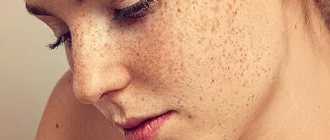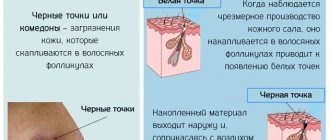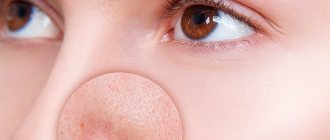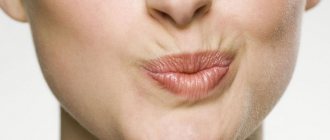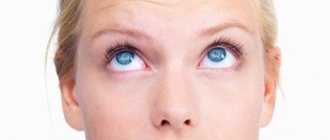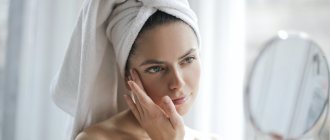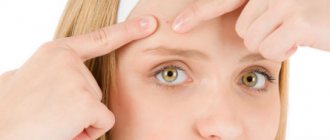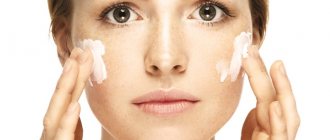Possible causes of age spots
Among the main reasons that cause the appearance of unsightly age spots on the face are the following:
- Hereditary predisposition. Such spots include, for example, nevi, which are formed due to the uneven formation and distribution of melanin in skin cells. Most often they are beige or brown in color. Every person has a certain number of congenital age spots. However, if they begin to enlarge, become injured, or there are too many of them, this can lead to the development of cancer, and therefore such spots must be removed in a timely manner.
- Exposure to ultraviolet rays. Prolonged and heavy sun exposure often leads to the formation of age spots, such as freckles. This is due to excess melanin production when exposed to ultraviolet rays. In this case, it is possible to avoid the appearance of age spots if you use protective creams before sunbathing. This is perhaps the only reason that you can eliminate on your own, although consulting a good cosmetologist in this case will not be superfluous. Currently, there are a lot of drugs that can eliminate or “whiten” such age spots very quickly.
- Use of low-quality cosmetics and perfumes . The appearance of age spots is associated with exposure to harmful components that are part of such products and directly affect the skin. Treatment will be required here.
- Folic acid deficiency . Occurs in the body during certain diseases of the circulatory and immune systems. As a result, skin changes are observed, which are manifested by the appearance of age spots. Folic acid may be insufficiently supplied from food and may be observed in folate deficiency anemia, pregnancy and a number of other conditions. A lack of vitamin C and copper in the body can also cause the appearance of age spots.
- Age-related skin changes . They appear after 50 years and are signs of age. These spots are called lentigo spots. They occur in areas that are most frequently exposed to ultraviolet radiation, namely the face and hands. Their occurrence is associated with biological changes occurring in the skin; menopause and increased estrogen levels cause an increase in the number of such spots.
- Hormonal changes . They are one of the most common causes of age spots.
Very often, so-called chloasma occurs on the face, abdomen and around the nipples and genitals of pregnant women. The formations are characterized by a very specific location. For example, on the face they are usually on the bridge of the nose, temples, chin or upper lip, forming the so-called pregnancy mask. The reason for their appearance is a change in the general hormonal background, which means changes in the content of estrogen and progesterone, which, while expecting a baby, are present in a woman’s body in a different proportion than at normal times.
Chloasma that appears during pregnancy tends to disappear on its own after childbirth. Accordingly, no special therapy is required in this case. But to try to avoid their appearance, you should spend less time in the sun, eat healthy and balanced, and do not experiment with cosmetics. You can lubricate your face and other dangerous areas with special creams with a high content of folic acid, which are available in a wide range today.
Hormonal imbalances are observed not only in pregnant women. Fluctuations in the level of progesterone and estrogen, which occur during the normal physiological cycle in women, can also cause age spots on the face. This is called melanosis, in the formation of which an increase in the level of estrogen plays a significant role, which stimulates the formation of melanin. More often, this problem is typical for brunettes whose skin belongs to the fourth phototype. The spots that form in this case are uneven in shape and are located on the forehead, temples, cheeks, in the area of the upper lip and above the upper lip.
Taking oral contraceptives , as well as topical estrogen, can also cause spots to appear. The appearance of chloasma is accompanied by the onset of menopause. The reason for their occurrence also lies in the level of estrogen and an increase in the synthesis of pigments.
Many serious diseases are also accompanied by an increase in the level of estrogen in the blood and, as a result, the formation of age spots on the face. This may include:
- thyroid diseases that affect hormonal levels in the body;
- ovarian cysts and tumors;
- panhypopituitarism;
- pituitary tumors accompanied by increased production of estrogen;
- pathology of the adrenal glands;
- stress;
- obesity (estrogens are produced by adipose tissue);
- some diseases of the liver and gall bladder.
It is quite difficult to deal with spots that arise due to hormonal disorders. Sometimes it is not enough to identify and eliminate the causes that led to their formation, and in some cases it is difficult to completely get rid of the disease itself. In such a situation, women often resort to the help of cosmetologists to cope with the problem. However, if the underlying cause continues to adversely affect the body, the spots will appear again.
- Features of metabolic processes . Metabolism in the body is very important. Some diseases lead to its disruption. As a result, excess melanin production occurs and pigment spots form. Gallstone disease, hepatitis A, diseases that lead to impaired absorption of vitamins and minerals in the intestines can also cause the formation of age spots.
- Nervous disorders . Stress is, although not the most common, one of the reasons for the appearance of age spots.
Classification and stages of development of skin hyperpigmentation
There is no generally accepted classification of skin pigmentation disorders.
According to one classification, they are conventionally divided into the following types:
- physiological (optional);
- acquired (pathological);
- genetic (independent of other factors).
According to another classification, there are two types of hypermelanosis: 1. Epidermal - brown coloration of the skin, caused by an increase in the amount of melanin in the epidermis. Epidermal hypermelanosis can be of several types: limited - café au lait spots, Becker's nevus, flat nevus; diffuse - scattered isolated spots (freckles), reticulated spots (congenital dyskeratosis) or poorly defined spots (post-inflammatory hyperpigmentation).
2. Dermal - caused by the presence of melanin in the dermis, a violation of the development of dermal melanocytes and macrophages (cells that capture and digest foreign and harmful particles). The skin takes on a gray, blue-gray or blue tint. A similar color can be caused by other factors not related to melanin: ochronosis (coloration of connective tissue brown or blue-black), tattoos, and the effects of medications.
Treatment
Age spots are not an independent disease, but a symptom. Therefore, before treating pigment spots that have arisen, it is necessary to find out the cause of their formation, and for this you will have to undergo examination by a gynecologist, endocrinologist, gastroenterologist and neurologist. Treatment begins with treating the underlying disease, and only then does it make sense to begin to discolor spots and eliminate skin defects.
Among the methods for eliminating age spots, the following are currently widely used:
- laser removal. This is one of the most effective and harmless ways to get rid of age spots.
- chemical peeling, which is effective only on superficial stains;
- photoremoval (photorejuvenation);
The treatment option must be determined by the doctor, since only a specialist can, taking into account the characteristics of the skin and the condition of the patient’s body, identify all possible contraindications.
Find out the cost
Peptides against hyperpigmentation
The peptide drug Aquashine is capable of slowing down the aging of the dermis at the cellular level.
Peptides are organic substances that regulate the condition of cells. When introduced into the body, they force cells to work correctly. Aquashine preparations contain several peptides. For example, Acetyl Decapeptide-3 activates the production of fibroblasts. Oligopeptide-24 improves skin regeneration, increases collagen production, improves tone, and reduces scars. Oligopeptide-34 stops the aging process, fills skin cells with energy, and reduces the appearance of pigmentation. Oligopeptide-72 prevents the formation of wrinkles and smoothes the skin. Oligopeptide-23 improves metabolism. Oligopeptide-51 shrinks pores and stimulates the formation of elastin. In addition to peptides, the products in the line contain hyaluronic acid, vitamins, 24 amino acids, minerals and other components.
Hyaluronic acid is contained in Aquashine preparations in two forms - high molecular weight and low molecular weight. At the same time, high molecular weight acid helps transport peptides into the layers of the skin and their accumulation, while low molecular weight acid quickly saturates the skin with moisture and serves as a “transport” for other components.
Infectious diseases
Measles, rubella, scarlet fever, chickenpox are infectious processes. Marks and blisters appear on the body. These diagnosed diseases imply that the patient is isolated from society.
Measles
It may manifest itself against the background of a cough or fever. The rash starts on the face and goes down to the heels. In appearance it looks like red bumps that can merge into one large spot. Even after the illness ends, marks may remain on the skin.
Rubella
This is a small rash accompanied by fever. The virus reaches humans through the air. At the initial stage, you feel unwell and weak. Body temperature does not exceed 380. A little later a runny nose is observed. Then a rash begins to appear in the face area, and further along the body. Spots – 6 mm. Complications from this pathology are more common in adults.
Products that help remove dark spots on the face
To remove dark spots on your face, you can use the following:
- Compress . Gauze must be moistened in: herbal infusion, lemon or grapefruit juice, curdled milk or kefir, currant or viburnum juice, parsley or cucumber juice and put on the face. The duration of the compress is 15 minutes, the frequency of execution is once every three days.
- Lotions of healing herbs . Infusions of parsley, licorice, dandelion, yarrow or bearberry help very well to get rid of pigmentation if you wipe your face with them every day, morning and evening.
- Lotions. Freshly squeezed juice of the above plants or a freshly prepared infusion must be applied to a specific area of the face (post-acne, forehead or spots). You can make lotions three times a week.
- Cosmetic cubes . You should freeze the juice, infusion or decoction of beneficial plants (rice can be used) and wipe the skin of your face, neck and décolleté every day.
- Brightening masks. They are easy to prepare and the price is affordable. Any medications included in their composition (hydrogen peroxide, white or blue clay, algae, brewer's yeast, etc.) can be purchased at the pharmacy.
- Aroma oils . You can add 2-4 drops of anti-pigment aromatic oil to the mask (if there are no allergic reactions): rosemary, citrus fruits (lemon, orange, grapefruit), bergamot, turmeric, oregano, patchouli, mint, eucalyptus, sandalwood, black pepper.
- Mineral water. It brightens the skin very well when washed or added to masks.
Read material on the topic: Lightening age spots: 11 beauty recipes
Hyaluronic acid against hyperpigmentation
Hyaluronic acid also effectively fights natural, age-related and other types of hyperpigmentation.
In particular, cosmetologists use drugs such as Restylane and Belotero in various modifications to remove skin defects. The drugs can be used either alone or in combination with various vitamins and skin-lightening substances. As part of a course of mesotherapy. The drugs themselves Restylane and Bnlotero perfectly moisturize the skin, create a long-lasting rejuvenation effect, fill fine wrinkles and skin unevenness.

